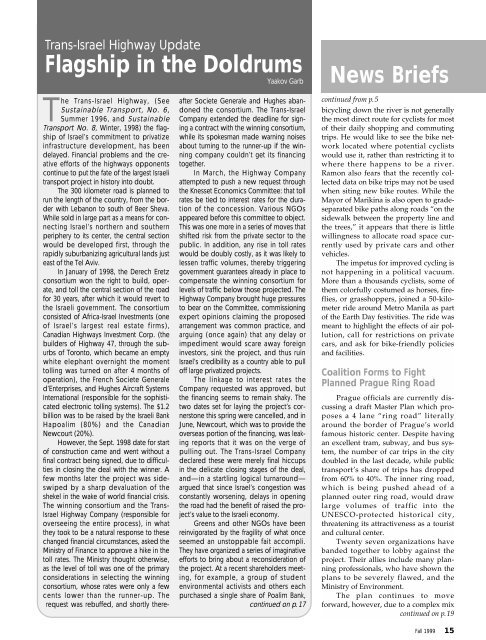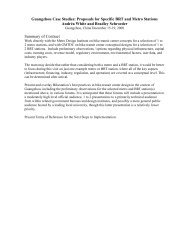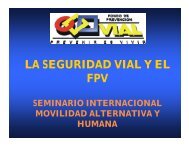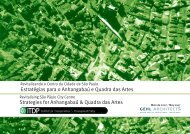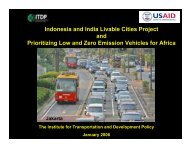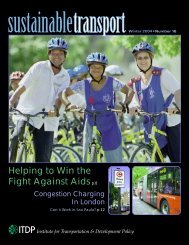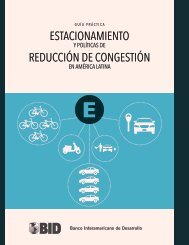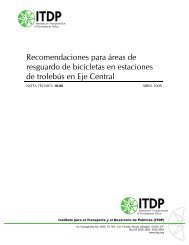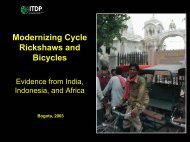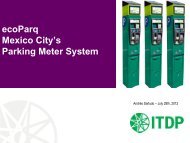Download PDF - ITDP | Institute for Transportation and Development ...
Download PDF - ITDP | Institute for Transportation and Development ...
Download PDF - ITDP | Institute for Transportation and Development ...
You also want an ePaper? Increase the reach of your titles
YUMPU automatically turns print PDFs into web optimized ePapers that Google loves.
Trans-Israel Highway Update<br />
Flagship in the Doldrums<br />
Yaakov Garb<br />
The Trans-Israel Highway, (See<br />
Sustainable Transport, No. 6,<br />
Summer 1996, <strong>and</strong> Sustainable<br />
Transport No. 8, Winter, 1998) the flagship<br />
of Israel’s commitment to privatize<br />
infrastructure development, has been<br />
delayed. Financial problems <strong>and</strong> the creative<br />
ef<strong>for</strong>ts of the highways opponents<br />
continue to put the fate of the largest Israeli<br />
transport project in history into doubt.<br />
The 300 kilometer road is planned to<br />
run the length of the country, from the border<br />
with Lebanon to south of Beer Sheva.<br />
While sold in large part as a means <strong>for</strong> connecting<br />
Israel’s northern <strong>and</strong> southern<br />
periphery to its center, the central section<br />
would be developed first, through the<br />
rapidly suburbanizing agricultural l<strong>and</strong>s just<br />
east of the Tel Aviv.<br />
In January of 1998, the Derech Eretz<br />
consortium won the right to build, operate,<br />
<strong>and</strong> toll the central section of the road<br />
<strong>for</strong> 30 years, after which it would revert to<br />
the Israeli government. The consortium<br />
consisted of Africa-Israel Investments (one<br />
of Israel’s largest real estate firms),<br />
Canadian Highways Investment Corp. (the<br />
builders of Highway 47, through the suburbs<br />
of Toronto, which became an empty<br />
white elephant overnight the moment<br />
tolling was turned on after 4 months of<br />
operation), the French Societe Generale<br />
d’Enterprises, <strong>and</strong> Hughes Aircraft Systems<br />
International (responsible <strong>for</strong> the sophisticated<br />
electronic tolling systems). The $1.2<br />
billion was to be raised by the Israeli Bank<br />
Hapoalim (80%) <strong>and</strong> the Canadian<br />
Newcourt (20%).<br />
However, the Sept. 1998 date <strong>for</strong> start<br />
of construction came <strong>and</strong> went without a<br />
final contract being signed, due to difficulties<br />
in closing the deal with the winner. A<br />
few months later the project was sideswiped<br />
by a sharp devaluation of the<br />
shekel in the wake of world financial crisis.<br />
The winning consortium <strong>and</strong> the Trans-<br />
Israel Highway Company (responsible <strong>for</strong><br />
overseeing the entire process), in what<br />
they took to be a natural response to these<br />
changed financial circumstances, asked the<br />
Ministry of Finance to approve a hike in the<br />
toll rates. The Ministry thought otherwise,<br />
as the level of toll was one of the primary<br />
considerations in selecting the winning<br />
consortium, whose rates were only a few<br />
cents lower than the runner-up. The<br />
request was rebuffed, <strong>and</strong> shortly thereafter<br />
Societe Generale <strong>and</strong> Hughes ab<strong>and</strong>oned<br />
the consortium. The Trans-Israel<br />
Company extended the deadline <strong>for</strong> signing<br />
a contract with the winning consortium,<br />
while its spokesman made warning noises<br />
about turning to the runner-up if the winning<br />
company couldn’t get its financing<br />
together.<br />
In March, the Highway Company<br />
attempted to push a new request through<br />
the Knesset Economics Committee: that toll<br />
rates be tied to interest rates <strong>for</strong> the duration<br />
of the concession. Various NGOs<br />
appeared be<strong>for</strong>e this committee to object.<br />
This was one more in a series of moves that<br />
shifted risk from the private sector to the<br />
public. In addition, any rise in toll rates<br />
would be doubly costly, as it was likely to<br />
lessen traffic volumes, thereby triggering<br />
government guarantees already in place to<br />
compensate the winning consortium <strong>for</strong><br />
levels of traffic below those projected. The<br />
Highway Company brought huge pressures<br />
to bear on the Committee, commissioning<br />
expert opinions claiming the proposed<br />
arrangement was common practice, <strong>and</strong><br />
arguing (once again) that any delay or<br />
impediment would scare away <strong>for</strong>eign<br />
investors, sink the project, <strong>and</strong> thus ruin<br />
Israel’s credibility as a country able to pull<br />
off large privatized projects.<br />
The linkage to interest rates the<br />
Company requested was approved, but<br />
the financing seems to remain shaky. The<br />
two dates set <strong>for</strong> laying the project’s cornerstone<br />
this spring were cancelled, <strong>and</strong> in<br />
June, Newcourt, which was to provide the<br />
overseas portion of the financing, was leaking<br />
reports that it was on the verge of<br />
pulling out. The Trans-Israel Company<br />
declared these were merely final hiccups<br />
in the delicate closing stages of the deal,<br />
<strong>and</strong>—in a startling logical turnaround—<br />
argued that since Israel’s congestion was<br />
constantly worsening, delays in opening<br />
the road had the benefit of raised the project’s<br />
value to the Israeli economy.<br />
Greens <strong>and</strong> other NGOs have been<br />
reinvigorated by the fragility of what once<br />
seemed an unstoppable fait accompli.<br />
They have organized a series of imaginative<br />
ef<strong>for</strong>ts to bring about a reconsideration of<br />
the project. At a recent shareholders meeting,<br />
<strong>for</strong> example, a group of student<br />
environmental activists <strong>and</strong> others each<br />
purchased a single share of Poalim Bank,<br />
continued on p.17<br />
bicycling down the river is not generally<br />
the most direct route <strong>for</strong> cyclists <strong>for</strong> most<br />
of their daily shopping <strong>and</strong> commuting<br />
trips. He would like to see the bike network<br />
located where most current <strong>and</strong><br />
News Briefs<br />
continued from p.5<br />
bicycling down the river is not generally<br />
the most direct route <strong>for</strong> cyclists <strong>for</strong> most<br />
of their daily shopping <strong>and</strong> commuting<br />
trips. He would like to see the bike network<br />
located where potential cyclists<br />
would use it, rather than restricting it to<br />
where there happens to be a river.<br />
Ramon also fears that the recently collected<br />
data on bike trips may not be used<br />
when siting new bike routes. While the<br />
Mayor of Marikina is also open to gradeseparated<br />
bike paths along roads “on the<br />
sidewalk between the property line <strong>and</strong><br />
the trees,” it appears that there is little<br />
willingness to allocate road space currently<br />
used by private cars <strong>and</strong> other<br />
vehicles.<br />
The impetus <strong>for</strong> improved cycling is<br />
not happening in a political vacuum.<br />
More than a thous<strong>and</strong>s cyclists, some of<br />
them colorfully costumed as horses, fireflies,<br />
or grasshoppers, joined a 50-kilometer<br />
ride around Metro Manila as part<br />
of the Earth Day festivities. The ride was<br />
meant to highlight the effects of air pollution,<br />
call <strong>for</strong> restrictions on private<br />
cars, <strong>and</strong> ask <strong>for</strong> bike-friendly policies<br />
<strong>and</strong> facilities.<br />
Coalition Forms to Fight<br />
Planned Prague Ring Road<br />
Prague officials are currently discussing<br />
a draft Master Plan which proposes<br />
a 4 lane “ring road” literally<br />
around the border of Prague’s world<br />
famous historic center. Despite having<br />
an excellent tram, subway, <strong>and</strong> bus system,<br />
the number of car trips in the city<br />
doubled in the last decade, while public<br />
transport’s share of trips has dropped<br />
from 60% to 40%. The inner ring road,<br />
which is being pushed ahead of a<br />
planned outer ring road, would draw<br />
large volumes of traffic into the<br />
UNESCO-protected historical city,<br />
threatening its attractiveness as a tourist<br />
<strong>and</strong> cultural center.<br />
Twenty seven organizations have<br />
b<strong>and</strong>ed together to lobby against the<br />
project. Their allies include many planning<br />
professionals, who have shown the<br />
plans to be severely flawed, <strong>and</strong> the<br />
Ministry of Environment.<br />
The plan continues to move<br />
<strong>for</strong>ward, however, due to a complex mix<br />
continued on p.19<br />
Fall 1999 15


